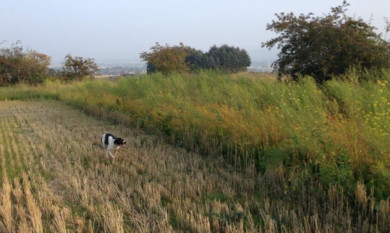If field margin management is to be an option under the new Environmental Focus Area (EFA) regulations, why not make the most of them as wild bird cover crops?
That is a question which has been posed by the Game and Wildlife Conservation Trust (GWCT) and partly answered by a small-scale field trial set up by member Benedict Lawson at Newton House, Auchtermuchty.
He has devoted a five-acre field in front of the house to exploring the merits of six different field margin mixes in a field which this year grew spring barley.
A beetle bank up the centre of the field completes the experiment.
The idea is to use various mixtures of pollen-rich and seed-shedding species to provide food and shelter for ground-nesting birds.
As evidence that it worked, a visiting group of GWCT members soon startled a healthy looking covey of partridges. With such a fickle bird species, that is not something that can be prearranged.
GWCT director Dr Adam Smith and Scottish senior adviser Hugo Straker pointed out that the cover crops, if sown in suitable combinations, could last several years.
“The key thing is not to present birds with an impenetrable barrier,” said Mr Straker.
“The crop should be open at the bottom and allow plenty of room for birds to access the middle of the cover. Often drills should have coulters blocked off to ensure a good row width.”
In one of the plots birdsfoot trefoil was the base for a 16-way mix which included various clovers, vetches, phacelia and fenugreek.
Another was based on chicory mixed with quinoa and gold of pleasure.
The mixes had been sourced from Kings Seeds through agronomy company Frontier and although they all had their own features, in general they were in Dr Smith’s estimation capable of over-wintering around 100 times more farmland birds than a bare stubble.
Widths could in practical terms vary from five to 25 metres but, as with many parts of the EFA regulation, clarity was needed as to whether these bird cover crops met the rules.
Gemma Hopkinson, policy officer with GWCT, has been following the EFA rules as they develop. Caution had to be exercised on features already in place (see letter below) through the Scottish Rural Development Programme to make sure there was no double-funding.
There are other grey areas. For instance if the field margin was grass based and was kept in place for more than five years, would it then be classified as permanent pasture meaning it could not be ploughed?
Mrs Hopkinson has discussed this with Scottish Government, and this has led her to believe there would be no restrictions on ploughing up a margin which is more than five years old as long as it is not in the year it is being claimed as part of an EFA and the land manager is still complying with the GAEC rules which will still require a two-metre margin from the centre of any hedge.
She also hoped farmers would voluntarily sow complete fallow fields under EFA with unharvested wild bird seed, and that this would be allowable.
There was also a warning over beetle banks. Many of these already exist as an in-field feature, but care would need to be taken to maintain a gap between the bank and a newly sown field margin.
This was likely to be a minimum of 20 metres but, as with many details of the new CAP, confirmation was still sought.
There can be little doubt that the Newton House trial shows the environmental benefits of field margins for farmland and game birds alike, and uptake deserves to be good.
Establishment and early management can be challenging, but the GWCT are confident that they understand the management techniques needed.
Now it just needs clarification of the CAP rules.
Mr Lawson is keen to allow anyone with an interest to see the Newton House trials. A visit can be arranged by emailing mail@benedictlawson.co.uk.
* In response to Ewan Pate’s Monday article asking for a more reasoned approach to greening,Virginia Fraser, West Mains of Rossie, Montrose, writes:
In the 18 years since I took over the family farm I have tried hard to make it ‘greener’, including signing up for RSS, LMO, LMC and SRDP.
Currently, of our 393 acres, we are managing 10 acres of wild bird seed, nearly nine acres of grass and water margins, 3 acres woodland (-acre planted last year), two acres species rich grassland, 1 acre wetland, plus 1,515 metres of hedges, most of which have been planted recently.
In short, over 16% of the farm is “green”.
Working with these schemes has not been easy. Every new acronym brought different rules for the same things.
For instance, a margin along a ditch was a water margin under LMO, but not under LMC, which only allowed grass margins; LMO did not allow cutting of any margins, LMC required it for all of them.
Now SRDP wants to include water margins and grass margins, and they are to be managed differently.
But at least these schemes were optional.
Along comes EFA, compulsory, with yet more measuring, more record-keeping and of course more rules devised, one suspects, by people who have never set foot in a field.
The Government still don’t know exactly how much of the existing schemes can be included in EFA. And the RSPB is moaning about farmers’ attitude . . . Honestly, it makes me feel like ploughing the whole lot up.
